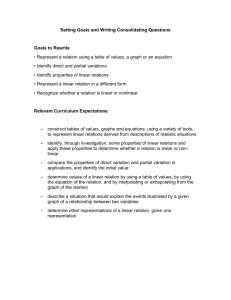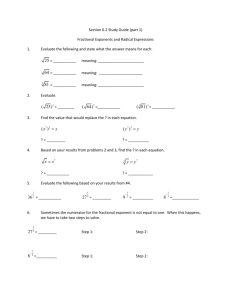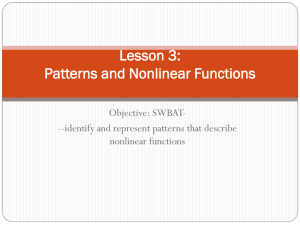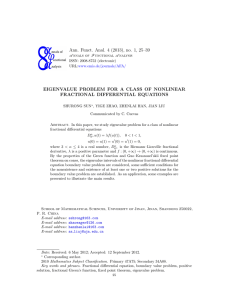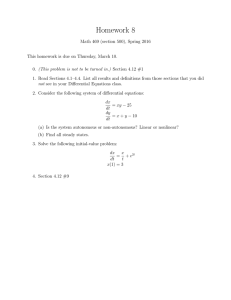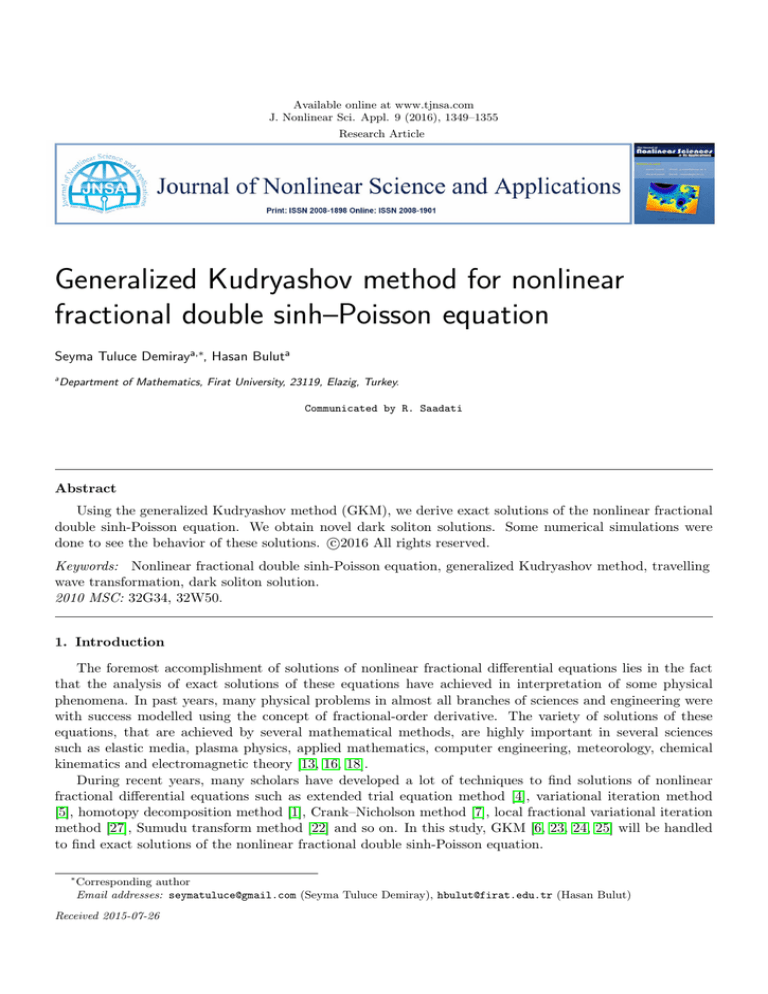
Available online at www.tjnsa.com
J. Nonlinear Sci. Appl. 9 (2016), 1349–1355
Research Article
Generalized Kudryashov method for nonlinear
fractional double sinh–Poisson equation
Seyma Tuluce Demiraya,∗, Hasan Buluta
a
Department of Mathematics, Firat University, 23119, Elazig, Turkey.
Communicated by R. Saadati
Abstract
Using the generalized Kudryashov method (GKM), we derive exact solutions of the nonlinear fractional
double sinh-Poisson equation. We obtain novel dark soliton solutions. Some numerical simulations were
c
done to see the behavior of these solutions. 2016
All rights reserved.
Keywords: Nonlinear fractional double sinh-Poisson equation, generalized Kudryashov method, travelling
wave transformation, dark soliton solution.
2010 MSC: 32G34, 32W50.
1. Introduction
The foremost accomplishment of solutions of nonlinear fractional differential equations lies in the fact
that the analysis of exact solutions of these equations have achieved in interpretation of some physical
phenomena. In past years, many physical problems in almost all branches of sciences and engineering were
with success modelled using the concept of fractional-order derivative. The variety of solutions of these
equations, that are achieved by several mathematical methods, are highly important in several sciences
such as elastic media, plasma physics, applied mathematics, computer engineering, meteorology, chemical
kinematics and electromagnetic theory [13, 16, 18].
During recent years, many scholars have developed a lot of techniques to find solutions of nonlinear
fractional differential equations such as extended trial equation method [4], variational iteration method
[5], homotopy decomposition method [1], Crank–Nicholson method [7], local fractional variational iteration
method [27], Sumudu transform method [22] and so on. In this study, GKM [6, 23, 24, 25] will be handled
to find exact solutions of the nonlinear fractional double sinh-Poisson equation.
∗
Corresponding author
Email addresses: seymatuluce@gmail.com (Seyma Tuluce Demiray), hbulut@firat.edu.tr (Hasan Bulut)
Received 2015-07-26
S. Tuluce Demiray, H. Bulut, J. Nonlinear Sci. Appl. 9 (2016), 1349–1355
1350
Onsager have considered a form of the sinh-Poisson equation in the late 1940s, though never published
it [8]. In terms of published work, the sinh-Poisson equation has been introduced by Joyce and Montgomery
[12]. The solutions of sinh-Poisson equation are relevant to the long-time states of turbulent two-dimensional
Navier–Stokes flows. This equation arises from a continuum (or “mean field”) limit of a very large number
of interacting, ideal, parallel line vortices [17]. It defines a stream function configuration of a stationary twodimensional Euler flow. This equation is closely related to some known integrable soliton models, and has a
lot of exact solutions in theoretical studies and applications [9]. The sinh-Poisson vorticity model equation
is privileged in that it is S-integrable. Moreover, it allows iterative solution-generating methods associated
with invariance under Backlund transformations, and is also proper to the bilinear operator method [26].
The sinh-Poisson equation occurs in many significant areas, particularly as vorticity equation in classical
hydrodynamics [2]. The occasion to investigate the sinh-Poisson equation arrives from the existing proofs
that this equation controls the asymptotic states of ideal fluids, or, more generally, of two-dimensional
systems that can be turned to the dynamics of point-like elements interacting by the potential which is the
inverse of the Laplacean operator [11, 20]. This equation is also found when there are two kinds of elements
such as positive and negative vorticity and they are of equal orders. Then, this equation governs the states
with maximum entropy of the discrete statistical system at negative temperatures [12]. This equation is
exactly integrable on periodic domains since it possesses a pair of Lax operators [21].
We consider the following nonlinear fractional double sinh-Poisson equation [3]
∂ 2α u ∂ 2β u
+ 2β = sinh u + sinh 2u, 0 < α, β < 1,
(1.1)
∂x2α
∂y
where α, β are the parameters defining the orders of the fractional derivatives.
Our purpose in this paper is to seek exact solutions of nonlinear fractional double sinh-Poisson equation.
In Section 2, we give the basic structure of GKM [6, 23, 24, 25]. In Section 3, as an application, we search
for exact solutions of nonlinear fractional double sinh-Poisson equation by means of GKM.
2. Basic Structure of GKM
In the past years, some scientists have developed the Kudryashov method [14, 15, 19]. But, in this paper,
we construct a generalized form of it.
We handle the following nonlinear partial differential equation of fractional order for a function u of two
real variables, space x and time y:
P (u, Dxα u, Dyβ u, . . .) = 0.
(2.1)
The general stages of the GKM are clarified as follows:
Step 1. Primarily, we must take the travelling wave solution of (2.1) in the form
u(x, y) = u(η), η =
kxα
cy β
+
,
Γ[1 + α] Γ[1 + β]
(2.2)
where k and c are arbitrary constants. By using the chain rule
Dx2α u = (σx )2
d2 u(η) 2α
Dx η,
dη 2
Dy2β u = (σy )2
d2 u(η) 2β
Dy η,
dη 2
(2.3)
where σx and σy are sigma indices [10]; without loss of generality, we can take σx = s and σy = r, where s
and r are constants. Substituting (2.2) and (2.3) into (2.1) yields the nonlinear ordinary differential equation
N (u, u0 , u00 , u000 , · · · ) = 0,
where the prime denotes differentiation wit respect to η.
Step 2. Assume that the exact solutions of (2.4) can be written in the form
PN
i
A [Q(η)]
i=0 ai Q (η)
u(η) = PM
=
,
j
B [Q(η)]
j=0 bj Q (η)
(2.4)
(2.5)
S. Tuluce Demiray, H. Bulut, J. Nonlinear Sci. Appl. 9 (2016), 1349–1355
where Q is
1
1±eη .
1351
We emphasize that the function Q is the solution of the equation
Qη = Q0 = Q2 − Q.
(2.6)
Taking into account (2.5), we gain
0
0
0
A B − AB 0
A0 Q0 B − AB 0 Q0
2
0 A B − AB
= (Q − Q)
,
u (η) =
=Q
B2
B2
B2
Q2 − Q Q2 − Q
0
0
00
00
0 0
0 2
(2Q
−
1)(A
B
−
AB
)
+
.
u00 (η) =
B(A
B
−
AB
)
−
2B
A
B
+
2A(B
)
B2
B
0
(2.7)
(2.8)
Step 3. According to the structure of the recommended method, we assume that the solution of (2.4)
can be written in the form
u(η) =
a0 + a1 Q + a2 Q2 + · · · + aN QN + · · ·
.
b0 + b1 Q + b2 Q2 + · · · + bM QM + · · ·
(2.9)
To compute the values M and N in (2.9) that are the pole orders for the general solution of (2.4), we
do as in the classical Kudryashov method on balancing the highest-order nonlinear terms in (2.4) and we
can constitute formulas for M and N . So we can attain some values of M and N .
Step 4. Replacing (2.5) into (2.4) yields a polynomial R(Q) of Q. By equating the coefficients of R(Q)
to zero, we acquire a system of algebraic equations. Solving this system, we can define λ and the variable
coefficients of a0 , a1 , a2 , . . . , aN , b0 , b1 , b2 , . . . , bM . In this way, we find the exact solutions to (2.4).
3. Application of GKM to Nonlinear Fractional Double sinh-Poisson Equation
In this section, we look for the exact solutions of nonlinear fractional double sinh-Poisson equation by
using GKM.
Example 3.1. We get the travelling wave solutions of (1.1) and take the transformation u(x, y) = u(η)
cy β
kxα
+ Γ[1+β]
where k and c are constants. By using the chain rule [10] and by taking σx = s
with η = Γ[1+α]
and σy = r, we obtain
∂αu
∂u ∂ α η
∂u
=
σ
= σx k = sku0 ,
(3.1)
x
∂xα
∂η ∂xα
∂η
∂u
∂
2α
α
α
α
∂η ∂ η
∂ u
∂
∂u
∂
∂u
= k 2 s2 u00 ,
=
sk
= sk α
= sk σx
(3.2)
2α
α
∂x
∂x
∂η
∂x
∂η
∂η ∂xα
∂β u
∂u ∂ β η
∂u
=
σ
= σy c = rcu0 ,
y
β
β
∂η ∂y
∂η
∂y
∂u
∂
β
2β
β
∂η ∂ β η
∂ u
∂
∂u
∂
∂u
= r2 c2 u00 .
= β rc
= rc β
= rc σy
∂η
∂η
∂η ∂y β
∂y 2β
∂y
∂y
(3.3)
(3.4)
Then, (1.1) turns to the following equation
(k 2 s2 + r2 c2 )u00 = sinh u + sinh 2u.
(3.5)
In order to implement GKM to (3.5), we take the transformations
sinh u =
eu − e−u
,
2
sinh 2u =
e2u − e−2u
, v = eu ,
2
(3.6)
S. Tuluce Demiray, H. Bulut, J. Nonlinear Sci. Appl. 9 (2016), 1349–1355
1352
then we obtain the following relations
u00 =
1 00
v − v −1
1
v 2 − v −2
v − 2 (v 0 )2 , sinh u =
, sinh 2u =
.
v
v
2
2
(3.7)
Putting (3.7) into (3.5), we get
2(k 2 s2 + r2 c2 )vv 00 − 2(k 2 s2 + r2 c2 )(v 0 )2 − v 4 − v 3 + v + 1 = 0
(3.8)
Setting (2.5) and (2.8) into (3.8) and balancing the highest order nonlinear terms of vv 00 and v 4 (3.8),
we obtain
2N − 2M + 2 = 4N − 4M =⇒ N = M + 1.
(3.9)
Choosing M = 1 so that N = 2, we infer
u(η) =
a0 + a1 Q + a2 Q2
,
b0 + b1 Q
(3.10)
(a1 + 2a2 Q)(b0 + b1 Q) − b1 (a0 + a1 Q + a2 Q2 )
,
u (η) = (Q − Q)
(b0 + b1 Q)2
0
u00 (η) =
+
2
(3.11)
Q2 − Q
2
(2Q
−
1)
(a
+
2a
Q)(b
+
b
Q)
−
b
(a
+
a
Q
+
a
Q
)
1
2
0
1
1
0
1
2
(b0 + b1 Q)2
(Q2 − Q)2 2a2 (b0 + b1 Q)2 − 2b1 (a1 + 2a2 Q)(b0 + b1 Q) + 2b21 (a0 + a1 Q + a2 Q2 ) .
3
(b0 + b1 Q)
(3.12)
The exact solutions of (1.1) are found as follows.
Case 1
1
a0 = i(i +
2
√
√
√ i
1 h
ia2
3)b0 , a1 = − i (−3i + 3)a2 + 6 3b0 , b1 = √ , c = −
6
3
q
− 32 − k 2 s2
r
.
(3.13)
If we substitute (3.13) into (3.10), we find dark soliton solutions of (1.1):
h
i
u1 (x, y) = ln K + L(1 − tanh(k1 xα + c1 y β )) ,
(3.14)
h
i
u2 (x, y) = ln K + L(1 − coth(k1 xα + c1 y β )) ,
(3.15)
where K =
Case 2
1
2 i(i
√
√
+ 3), L = − i 2 3 , k1 =
k
2Γ(1+α)
and c1 =
1
− 2Γ(1+β)
q
− 32 −k2 s2
.
r
√
√
1
1
ia2
ia2
a0 = i(3i + 3)a2 , a1 = (3 + i 3)a2 , b0 = − √ , b1 = − √ , c = −
6
6
3
3
q
− 32 − k 2 s2
r
.
(3.16)
When we put (3.16) into (3.10), we acquire dark soliton solutions of (1.1):
h
i
u3 (x, y) = ln K + L(1 + tanh(k1 xα + c1 y β )) ,
(3.17)
h
i
u4 (x, y) = ln K + L(1 + coth(k1 xα + c1 y β )) .
(3.18)
Case 3
√
1
i
ia2
2ia2
1
√
a0 = (3 + i 3)a2 , a1 = −1 −
a2 , b0 = − √ , b1 = √ , c = −
6
2
3
3
3
q
− 32 − 4k 2 s2
r
.
(3.19)
S. Tuluce Demiray, H. Bulut, J. Nonlinear Sci. Appl. 9 (2016), 1349–1355
1353
Figure 1: The graph of imaginary values of (3.20) is drawn for k = 1, r = 0.9, s = 0.8, α = 0.25, β = 0.75, −35 < x < 35,
−1 < y < 1 and the second graph shows imaginary values of (3.20) for −35 < x < 35, y = 1.
Figure 2: The graph of real values of (3.20) is drawn for k = 1, r = 0.9, s = 0.8, α = 0.25, β = 0.75, −35 < x < 35, −1 < y < 1
and the second graph shows real values of (3.20) for −35 < x < 35, y = 1.
If we set (3.19) into (3.10), we procure dark soliton solutions of (1.1)
"
!#
1
1
α + c yβ ) 2
−
tanh(k
x
1
2
2
2
,
u5 (x, y) = ln K + P
tanh(k1 xα + c2 y β )
"
u6 (x, y) = ln K + P
√
where P = i 3 and c2 =
Case 4
1
2
2 !#
− 21 coth(k1 xα + c2 y β )
,
coth(k1 xα + c2 y β )
(3.20)
(3.21)
q
− 23 −4k2 s2
1
.
− 4Γ(1+β)
r
√
√
√
√
1
1
1
a2
1 − k 2 s2
a0 = (1 + 2)a2 , a1 = − (2 + 2)a2 , b0 = − (1 + 2)a2 , b1 = √ , c = −
.
4
2
4
r
2
When we embed (3.22) into (3.10), we attain dark soliton solutions of (1.1)
"
√ #
tanh(k1 xα + c3 y β ) tanh(k1 xα + c3 y β ) − 2
√
u7 (x, y) = ln
,
− 2 tanh(k1 xα + c3 y β ) − 1
√ #
coth(k1 xα + c3 y β ) coth(k1 xα + c3 y β ) − 2
√
u8 (x, y) = ln
,
− 2 coth(k1 xα + c3 y β ) − 1
(3.22)
(3.23)
"
1
where c3 = − 2Γ(1+β)
√
1−k2 s2
.
r
(3.24)
S. Tuluce Demiray, H. Bulut, J. Nonlinear Sci. Appl. 9 (2016), 1349–1355
1354
Figure 3: The graph of imaginary values of (3.23) is drawn for k = 2, r = 0.9, s = 0.8, α = 0.75, β = 0.5, 0 < x < 25, 0 < y < 1
and the second graph shows imaginary values of (3.23) for 0 < x < 25, y = 1.
Figure 4: The graph of real values of (3.23) is drawn for k = 2, r = 0.9, s = 0.8, α = 0.75, β = 0.5, 0 < x < 25, 0 < y < 1 and
the second graph gives real values of (3.23) for 0 < x < 25, y = 1.
Remark
3.2. By his method, Kudryashov has found exact solution of the equation considered as u(η) =
PN
i (η). But we construct a generalized form of his method and find an exact solution of equation
a
Q
i=0 i
(1.1) in the form (2.5). Necessary calculations are performed via Mathematica, Release 9. As far as we
know, all the solutions of (1.1) that we reported here, are new and are not trackable in the former literature.
In Figures 1–2, we plot two- and three-dimensional graphics of imaginary and real values of (3.20), which
illustrate the dynamics of solutions with appropriate parametric selections. Also in Figures 3–4, we draw
two- and three-dimensional graphics of imaginary and real values of (3.23), which illustrate the dynamics
of solutions with convenient parametric choices.
4. Conclusion
In this paper, we derive exact solutions of nonlinear fractional double sinh-Poisson equation by the help
of GKM. Thus, we attain dark soliton solutions of this equation. According to these results, generalized
Kudryashov method is influential and powerful in providing new exact solutions of nonlinear fractional
differential equations. We have succeeded in constructing a proper algorithm to get exact solutions of this
equation. We believe that the proposed method can also be implemented to other nonlinear fractional
differential equations which arise in physical sciences.
References
[1] A. Atangana, S. Tuluce Demiray, H. Bulut, Modelling the Nonlinear Wave Motion within the Scope of the
Fractional Calculus, Abstr. Appl. Anal., 2014 (2014), 7 pages. 1
[2] T. Bartsch, A. Pistoia, T. Weth, N-vortex equilibria for ideal fluids in bounded planar domains and new nodal
solutions of the sinh-Poisson and the Lane-Emden-Fowler equations, Commun. Math. Phys., 297 (2010), 653–686.
1
[3] A. Biswas, A. H. Bhrawy, M. A. Abdelkawy, A. A. Alshaery, E. M. Hilal, Symbolic Computation of Some Nonlinear
Fractional Differential Equations, Rom. J. Phys., 59 (2014), 433–442. 1
S. Tuluce Demiray, H. Bulut, J. Nonlinear Sci. Appl. 9 (2016), 1349–1355
1355
[4] H. Bulut, Classification of exact solutions for generalized form of K(m,n) equation, Abstr. Appl. Anal., 2013
(2013), 11 pages. 1
[5] H. Bulut, H. M. Baskonus, S. Tuluce, The solutions of homogenous and nonhomogeneous linear fractional differential equations by variational iteration method, Acta Univ. Apulensis, 36 (2013), 235–243. 1
[6] H. Bulut, Y. Pandir, S. Tuluce Demiray, Exact Solutions of Time-Fractional KdV Equations by Using Generalized
Kudryashov Method, Internat. J. Modeling Optim., 4 (2014), 315–320. 1, 1
[7] H. Bulut, S. Tuluce Demiray, M. Kayhan, The Approximate Solutions Of Time-Fractional Diffusion Equation By
Using Crank Nicholson Method, Acta Univ. Apulensis, 40 (2014), 103–112. 1
[8] G. L. Eyink, K. R. Sreenivasan, Onsager and the theory of hydrodynamic turbulence, Rev. Mod. Phys., 78 (2006),
87–135. 1
[9] D. Gurarie, K. W. Chow, Vortex arrays for sinh-Poisson equation of two-dimensional fluids: Equilibria and
stability, Phys. Fluids, 16 (2004), 3296–3305. 1
[10] J-H. He, S. K. Elagan, Z. B. Li, Geometrical explanation of the fractional complex transform and derivative chain
rule for fractional calculus, Phys. Lett. A, 376 (2012), 257–259. 2, 3.1
[11] R. Jackiw, S-Y. Pi, Classical and quantal nonrelativistic Chern-Simons theory, Phys. Rev. D, 42 (1990), 3500–
3513. 1
[12] G. Joyce, D. Montgomery, Negative temperature states for a two dimensional guiding center plasma, J. Plasma
Phys., 10 (1973), 107–121. 1
[13] A. A. Kilbas, H. M. Srivastava, J. J. Trujillo, Theory and applications of fractional differential equations, Elsevier,
Amesterdam, (2006). 1
[14] N. A. Kudryashov, One method for finding exact solutions of nonlinear differential equations, Commun. Nonlinear
Sci. Numer. Simulat., 17 (2012), 2248–2253. 2
[15] J. Lee, R. Sakthivel, Exact travelling wave solutions for some important nonlinear physical models, Pramana J.
Phys., 80 (2013), 757–769. 2
[16] K. S. Miller, B. Ross, An Introduction to the Fractional Calculus and Fractional Differential Equations, Wiley,
New York, (1993). 1
[17] D. Montgomery, W. H. Matthaeus, W. T. Stribling, D. Martinez, S. Oughton, Relaxation in two dimensions and
the ”sinh-Poisson” equation, Phys. Fluids A, 4 (1992), 3–6. 1
[18] I. Podlubny, Fractional differential equations, Academic Press, San Diego, (1999). 1
[19] P. N. Ryabov, D. I. Sinelshchikov, M. B. Kochanov, Application of the Kudryashov method for finding exact
solutions of the high order nonlinear evolution equations, Appl. Math. Comput., 218 (2011), 3965–3972. 2
[20] F. Spineanu, M. Vlad, Self-duality of the asymptotic relaxation states of fluids and plasmas, Phys. Rev. E, 67
(2003), 1–4. 1
[21] A. C. Ting, H. H. Chen, Y. C. Lee, Exact solutions of a nonlinear boundary value problem: The vortices of the
two-dimensional sinh-Poisson equation, Phys. D, 26 (1987), 37–66. 1
[22] S. Tuluce Demiray, H. Bulut, F. B. M. Belgacem, Sumudu Transform Method for Analytical Solutions of Fractional
Type Ordinary Differential Equation, Math. Probl. Eng., 2015 (2015), 6 pages. 1
[23] S. Tuluce Demiray, Y. Pandir, H. Bulut, Generalized Kudryashov Method for Time-Fractional Differential Equations, Abstr. Appl. Anal., 2014 (2014), 13 pages. 1, 1
[24] S. Tuluce Demiray, Y. Pandir, H. Bulut, The investigation of exact solutions of nonlinear time-fractional KleinGordon equation by using generalized Kudryashov method, AIP Conference Proc., 1637 (2014), 283–289. 1, 1
[25] S. Tuluce Demiray, Y. Pandir, H. Bulut, The Analysis of The Exact Solutions of The Space Fractional Coupled
KD Equations, AIP Conference Proc., 1648 (2015), 1–5. 1, 1
[26] Z-H. Xu, H-L. Chen, D-Q Xian, Breather-Type Periodic Soliton Solutions for (1+1)-Dimensional Sinh-Poisson
Equation, Commun. Theor. Phys., 57 (2012), 400–402. 1
[27] X-J. Yang, D. Baleanu, Y. Khan, S. T. Mohyud-din, Local fractional variational iteration method for Diffusion
and wave equations on cantor sets, Rom. J. Phys., 59 (2014), 36–48. 1


